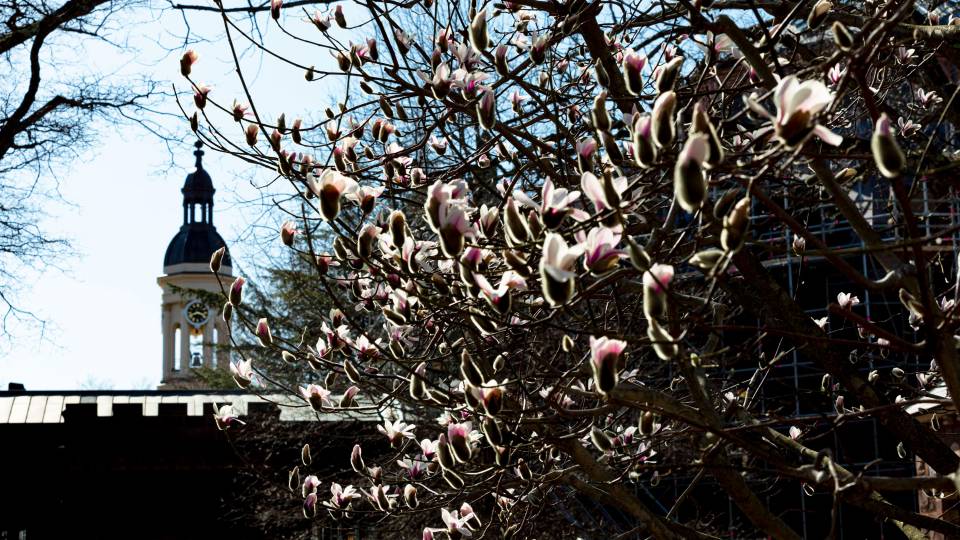This week a newly formed Portraiture Nominations Committee has started soliciting recommendations for up to 10 portraits that will be commissioned this year to begin to expand the University's campus portrait collection, which is maintained by the Princeton University Art Museum. Members of the campus community and the greater Princeton community are encouraged to submit suggestions online.
Launched as one of three working groups that are part of the multi-constituency Campus Iconography Committee (CIC), the Portraiture Working Group was led by Professor of History Marni Sandweiss. The working group recommended the creation of the Portraiture Nominations Committee to focus on expanding the campus portrait collection to reflect the increasingly diverse Princeton community. The working group outlined selection criteria for the new committee to consider, including a focus on honoring Princeton affiliates of achievement during the past 75 years in a particular field, "in the nation’s service and the service of humanity," or in making a significant contribution to the culture of Princeton University.
The University has not formally expanded the portrait collection since the mid-19th century when President John Maclean commissioned portraits of Princeton’s earlier presidents. Since that time, the only routine additions to the collection have been portraits of the president and the deans of the Graduate School and the School of Engineering and Applied Science.
"This is the first time the University has adopted specific criteria and a planned expansion for the collection beyond University officers," Treby Williams, executive vice president and co-chair of the CIC said. "I appreciate the thoughtful criteria established by the working group of faculty, students and administrators to diversify the subjects to be honored by the inclusion in the University portrait collection."
The Portraiture Nominations Committee will collect suggestions, perform research and recommend portrait subjects to the executive vice president and the provost, who will review and endorse selections for President Christopher L. Eisgruber's approval. The location of each portrait will be informed by the portrait subject. The broader work of the committee includes the possibility of creating an enhanced web presence with a map of portrait locations throughout campus as well as additional information about each portrait subject.
The CIC was established a year ago, in response to a recommendation from the Trustee Committee on Woodrow Wilson's Legacy at Princeton. The establishment of the CIC also grew out of conversations that took place between the administration and various student groups, including Princeton Latinos y Amigos, the Latinx community and the Black Justice League, as well as the Task Force on Diversity, Equity and Inclusion.
In addition to the Portraiture Working Group, the CIC established two other working groups: Princeton history and public spaces. Each group submitted reports and recommendations in spring 2017, including background research, vision and values by which the CIC should consider opportunities.
"The three CIC working groups — portraiture, Princeton history and public spaces — produced more thoughtful and critically engaged recommendations for moving forward than I could have ever imagined," said Carolyn Rouse, professor of anthropology and director of the Program in African Studies, and a co-chair of the committee. "Having been produced by a diverse committee, the recommendations demonstrate how important diversity is to what Princeton does best, which is knowledge production."
Senior Amina Simon is a student member of the CIC. "I hope I contribute a 'receiving-end' perspective to the ideas the committee proposes, bringing the University's processes in touch with student experiences," she said. "As a concentrator in African American studies, I have learned the value of looking deeply at Princeton's history — something I believe the members of the CIC have been doing."
This 2017-18 academic year, the focus of the CIC has shifted to implementation. Based on recommendations from the Princeton History Working Group, next steps include creating new walking tours to tell some of the lesser known stories of Princeton's history; establishing historical markers on campus, both physical and virtual; and integrating these histories into student orientation materials.
The Public Spaces Working Group is already working with campus partners to identify opportunities to enliven spaces on campus to reflect and connect with the diverse campus community, including the EQuad Café and spaces in residential colleges. Additionally, several spaces have been identified for enhanced adornments, including Firestone Library's third floor reading room, Chancellor Green Lower Hyphen, spaces in Frist Campus Center and academic spaces around campus.
The deliberate expansion of the University's portrait collection, along with other initiatives emerging from the CIC around telling Princeton's history and diversifying spaces around campus, support the University's aspiration to reflect the increasing diversity of the University and a campus that is welcoming to all its members.
To submit a suggestion to the Portraiture Nominations Committee, please use the online Portraiture Suggestion Form.





